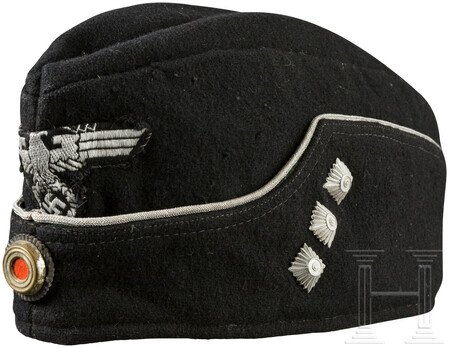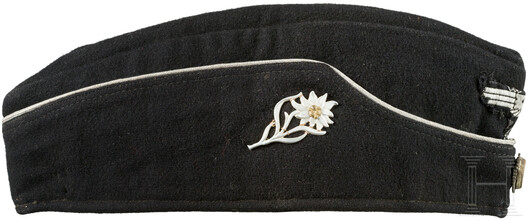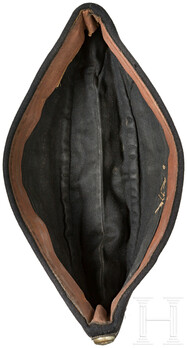NSKK Sturmführer Field Cap 2nd Pattern
CATEGORY: Version
SKU: 53.GOR.01.03.01.02.010.000
Estimated market value:



Estimated market value:
The NSKK (Nationalsozialistisches Kraftfahr-Korps = National Socialist Motor Corps) was a paramilitary organisation affiliated with the NSDAP, specialising in anything related to the driving of motorised vehicles. NSDAP officials recognised the need for access to cars and trucks for both transportation and propaganda purposes as early as 1922, and certain steps were taken to ensure this need was met. However, it took until April of 1930 for a specialised motor organisation to be officially founded. This organisation was named NSAK (Nationalsozialistisches Automobil-Korps = National Socialist Automobile Corps), but was renamed to NSKK less than 13 months later.
Initially, the NSAK/NSKK was under the control of the SA and existed next to its parent organisation’s own driving-related sub-organisation, the Motor-SA. This changed after the “Night of the Long Knives”, in which many SA leaders were purged and the organisation was substantially disempowered. After July of 1934, the NSKK became an independent organisation whose leader, NSKK-Korpsführer Adolf Hühnlein, answered directly to Adolf Hitler.
The main tasks of the NSKK were to provide transportation for all organisations of the Third Reich, to train and instruct boys and men (and a number of women) in mechanics and driving, and to assist police in regulating traffic. During the mid 1930s, the organisation also provided roadside assistance.
With the onset of the war, the NSKK’s tasks underwent certain changes. Instructing both civilians and soldiers in the driving and maintenance of armored vehicles became a higher priority. The NSKK also began working closely with other organisations, for example Organisation Todt (OT), by providing transportation of workers and supplies for the colossal building project that was the fortification of Germany’s Western border, the Siegfried Line (or Westwall). During the war, the NSKK provided much of the transportation needs for the German Army and the Luftwaffe, including the transport of troops, weapons and ammunition, and building materials, for example for the construction of air bases in the newly conquered territories in Eastern Europe after the attack on Soviet Russia in the summer of 1941.
Parts of the NSKK would come under the control of architect Albert Speer who took over OT after the death of Fritz Todt in 1942, leading to the creation of Transport Brigade Speer (later Transport Corps Speer), which would eventually completely sever its ties to the NSKK.
The Field Cap was worn during field duties and exercises, but also during driving duty. It became the most popular NSKK cap, especially among the lower ranks, since it was the most practical piece of headgear, as it could easily be folded and put away. The cap is usually black, but was also produced in olive-brown.
The earliest caps are easily identifiable, since they feature only a single button to hold the side flaps together at the front. This button was still without the embossed NSKK eagle. Later caps feature two buttons, and those buttons feature the embossed NSKK eagle emblem superimposed over a spoked wheel.
The cap’s design underwent a noticeable change, resulting in a 1st and a 2nd pattern.
The 1st pattern cap features side flaps that could be lowered to protect the wearer’s ears during inclement weather. With the 2nd pattern cap, however, the flaps were permanently affixed to the sides of the cap. This was introduced in March of 1939, but both patterns were worn until the end of the war. On the 2nd pattern caps, the curvature of the flap is different as well, rising more suddenly around the embroidered eagle insignia and then being straight for a longer portion around the back of the cap.
The embroidered eagle insignia was worn on the left side of the cap. The embroidered eagle had a cloth backing in the shape of a downward pointing triangle and in the colour of the wearer’s region. These regional colours were based on the same ones used by the SA. Please consult the SA Headgear items for more details. The only exceptions to the rule were that corps and group leaders used a carmine (karmesinrot) backing and the staff of motor groups used a vermilion (zinnoberrot) backing.
In December of 1936, so-called “Tresse” (braid) was introduced, taking the form of a diagonal band on the left side of the cap. It indicated the duty status of certain Officers. In this, Tresse was not an indicator of rank, but rather of certain functions. The bands of Tresse differed in size, colours, and displayed patterns, depending on the wearer’s status.
In March of 1939, several changes were made. The embroidered eagle insignia was changed for Officer ranks. Now, a larger eagle insignia on a cut-out black backing was worn, contrary to the smaller eagle on a coloured downward facing triangle backing for lower ranks.
The bands of Tresse were discontinued. Instead, silver piping for Officer ranks (Sturmführer and up) was introduced, as well as rank insignia on the left side of the cap, in a similar style as those used on collar tabs.
The rank insignia were made up of diagonal embroidered parallel stripes known as “Litzen” and/or four-sided silver metal pips, as well as silver metal oak leaves (and pips, where applicable) for the highest Officer ranks.
Obergruppenführer wore a bundle of three oak leaves with two acorns and one pip.
Gruppenführer wore a bundle of three oak leaves with two acorns.
Brigadeführer wore a bundle of two oak leaves with two acorns and one pip.
Oberführer wore a bundle of two oak leaves with two acorns.
Standartenführer wore a single oak leaf with two acorns.
Oberstaffelführer wore two parallel stripes with four pips, arranged in a diagonal line.
Staffelführer wore four pips, arranged in a diagonal line.
Sturmhauptführer wore two parallel stripes, four pips, arranged in a diagonal line, and another two parallel stripes.
Obersturmführer wore two parallel stripes with three pips, arranged in a diagonal line.
Sturmführer wore three pips, arranged in a diagonal line.
Obertruppführer wore two parallel stripes with two pips.
Truppführer wore two pips.
Oberscharführer wore two parallel stripes with one pip.
Scharführer wore one pip.
Rottenführer wore four parallel stripes.
Members in the rank of Sturmmann wore two parallel stripes.
Members in the rank of NSKK-Mann wore no rank insignia on their caps.

Comments
Sign in to comment and reply.


Scroll Top